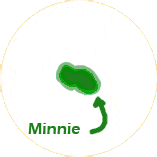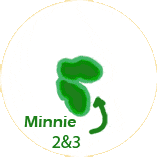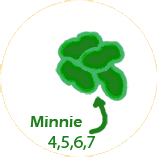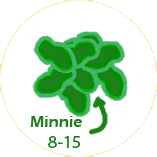Viable plate count
So we can't poke a cell to see if it's alive -- how else can we make the call? What do live cells do that dead cells don't? Well, one big thing is, live cells grow and reproduce. And they do it fairly quickly (remember, every half hour or so in the case of meningicocci). So if we were to take a batch of cells and wait a day or so, we would soon know if they were alive or not.
Let's refine this idea a little, by following... A day in the life of a microbe
Out in the real world (like in your nose, throat, or bloodstream), meningicocci are limited by temperature and nutrients. In the lab, we're going to put the meningicocci on a media, which will do two things:
- take away limiting factors, and
- fix each individual cell in one place, so it doesn't get moved around.
So, let’s watch a single meningicoccus cell, conveniently named Minnie, sitting in the middle of a batch of media. The media has every creature comfort that Minnie could want, and she pulls in sugar as fast as she can. Soon she’s grown out of her membrane and she splits in half, creating little Minnies 2 and 3. These two also pull in sugar as fast as they can, and a half hour later, they too start to feel ready to split, so they do. Minnies 4, 5, 6 and 7 keep going.
time: 0 min |
time: 50 min |
time: 1 hr 40 min |
time: 2 hrs 40 min |
|---|
Luckily, none of the Minnie's move around much. Although some bacteria can move over the surface of agar, meningicocci are good at doing this. So, they’re all stuck sitting in a little pile, but they don’t mind, as long as there’s plenty of sugar to go around. And pretty soon we have a pile consisting of Minnies 8 through 15, all descendents of Minnie the First. And so on.
Eventually (after about 24 hours) this pile will be big enough for one of us hulking human beings to see without even using a microscope. This tiny but visible pile is called a colony, and the original Minnie was the original colony-forming unit, or CFU.
Of course Minnie was probably not the only CFU around. Over on the other side of the agar, Ginnie was sitting around, minding her own business, enjoying the warmth and sugar, and growing at the same rate. So while a few million descendants of Minnie formed a colony on one side of the plate, a few million descendants of Ginnie form a colony of the other side. And so on, one colony for each original colony forming unit.
Copyright University of Maryland, 2007
You may link to this site for educational purposes.
Please do not copy without permission
requests/questions/feedback email: mathbench@umd.edu